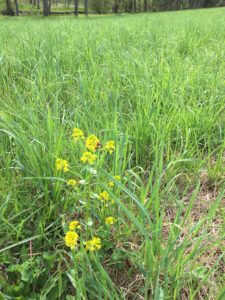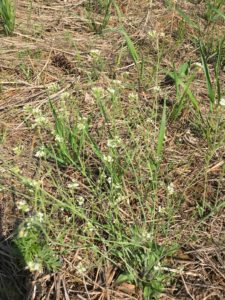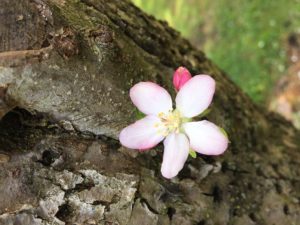April: Warp Speed
Like a dream, spring took hold in April. Along the edges of the meadow, we have planted 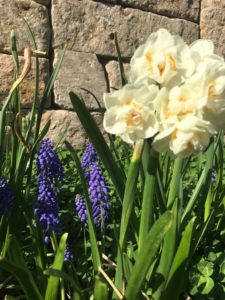 hundreds of Daffodil and Grape Hyacinth bulbs. While the meadow is warming up and getting ready to erupt, there is a burst of color and scent around the property that makes signals that spring has arrived and make you smile. April can still be uninvitingly cold so plucking a few of the little hyacinths to enjoy on the windowsill is a delight!
hundreds of Daffodil and Grape Hyacinth bulbs. While the meadow is warming up and getting ready to erupt, there is a burst of color and scent around the property that makes signals that spring has arrived and make you smile. April can still be uninvitingly cold so plucking a few of the little hyacinths to enjoy on the windowsill is a delight!
It always amazes me how planting goes from zero to frantic in a day – that is April. You can almost see the grasses go from greening up to full height and blooming!
In Year 1, construction delays pushed planting back to May. 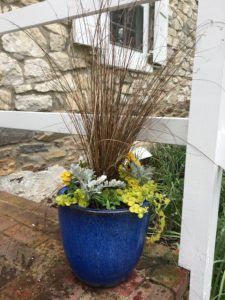 This year the seeds that had been ordered on-time and had arrived by mid-March were waiting patiently in the shed to be site mixed. The planting plan focuses on concentrating blooms near the house and then, as the field moves uphill, gradually reducing the number of wildflowers and transitioning to grass.
This year the seeds that had been ordered on-time and had arrived by mid-March were waiting patiently in the shed to be site mixed. The planting plan focuses on concentrating blooms near the house and then, as the field moves uphill, gradually reducing the number of wildflowers and transitioning to grass.
The hand-crafted, site-made mixes included: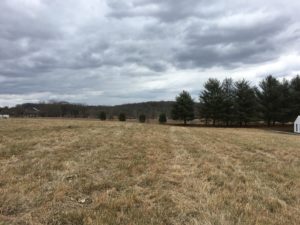
- In the Old Construction Road Area:
- Near the house, a concentration of annual and perennial wildflowers and Grasses with 70ish% Flowers (ERNMX 168), 10% the grass mix (ERNMX
- 117/123 combination), 10% Native Sunflower and 10% Blue Mist with a pinch of Baptisia. The mixes also contained Cosmos, Corn Flower and Cleome seeds that were field gathered last year.
- About 20’ into the field a transition to a 50/50 mix of 117/123 and 168 plus a smattering of Native Sunflower and Joe Pye Weed.
- After another 20’, this transitions again to a 10/90 mix of 117/123 and 168 with a smattering of Native Sunflower.
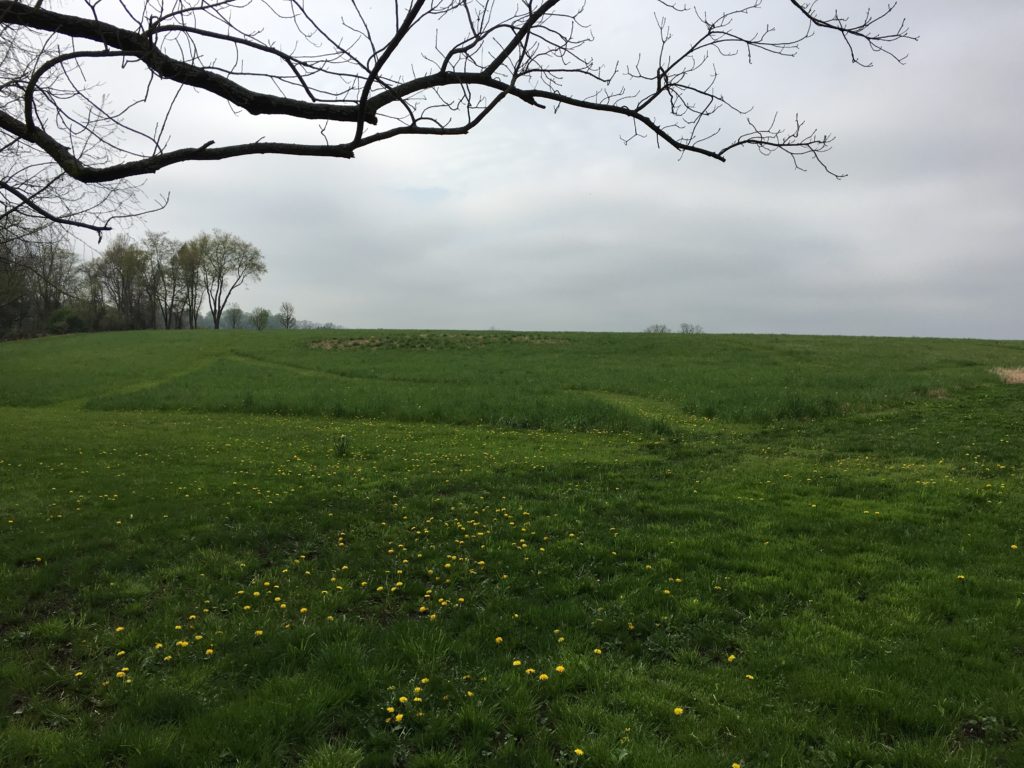 In the main meadow:
In the main meadow:
- Near the house are flowers and Grasses with 70ish% Flowers (ERNMX 168), 10% the grass mix (ERNMX 117 /123 combination), 10% Native Sunflower and 10% Blue Mist and a smattering of Baptisia.
- About 30’ into the field a transition to a 50/50 mix of 117/123 and 168 plus a smattering of Native Sunflower and Joe
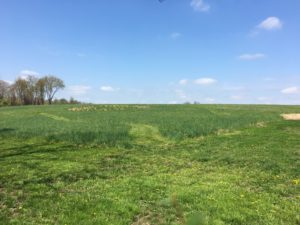 Pye Weed with Blue Mist along the path edges. The mix also included Milkweed and New England Aster seed that were field gathered last year.
Pye Weed with Blue Mist along the path edges. The mix also included Milkweed and New England Aster seed that were field gathered last year. - After another 20’, this transitions again to a 10/90 mix of 117/123 and 168 and a smattering of Native Sunflower and Joe Pye.
- Down near the stream:
- Overseeding with the ERNMX 117/123 grass mix with a smattering of Baptisia and Milkweed that was field collected last year.
- Up on the top of the hill:
- Overseeding with Eastern Ecotype (ERNMX 177).
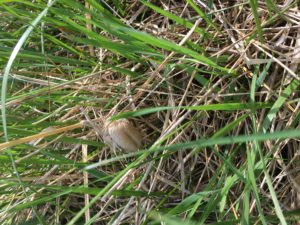 As instructed by Ernst, I stirred the seed mixes into cat litter to allow for easier hand-casting. This n
As instructed by Ernst, I stirred the seed mixes into cat litter to allow for easier hand-casting. This n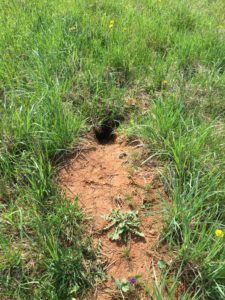 ot only allows you to see where the seed has fallen but it reduces the amount of seed per area. Joe Pye Weed seed is teeny-tiny and Blue Mist is super fluffy – without a dispersal medium like cat litter or sand, these would either be everywhere in the field or all together in one place.
ot only allows you to see where the seed has fallen but it reduces the amount of seed per area. Joe Pye Weed seed is teeny-tiny and Blue Mist is super fluffy – without a dispersal medium like cat litter or sand, these would either be everywhere in the field or all together in one place.
Hand-casting acres of land is long, tiring work but it gives you time to slow down and really look at the condition of the soil, to experience the minute contours of the land, to see who has made a home in the field, who is getting ready to hatch, and to see where and which invasive plants are taking root. To counter the tiring work the trusty tractor became a mobile potting bench.
April is also a month of firsts: first flowers, first pollinators, first apple blossoms. It is a month filled with the awakening sounds of frogs in the nearby wetlands, the calls of birds, the burbling of the stream, the quiet breeze through the forest edge. April is also a month of movement.
In February and March, the grasses are stiff with ice and the only movement is in the stiff branches of the trees and the flight of geese massing and practicing for migratory flights. In April, the grasses are greening up and growing enough to wave in the fresh breezes, the migratory birds have returned to flit, spar, and soar over the fields, and the little creatures who inhabit the meadow – voles, moles, ground hogs and others are zipping about freshening up their holes and tunnels. They make the grasses quiver and rustle as they move about.
May: Compaction and A Pulpit Surprise
The last frost date in the meadow is supposed to be around Mother’s Day (5/14) so it is the intrepid flower who blooms before then. Most of these are small flowers that hug low to the ground. The pollinators are mostly small flies and bees but on warm days the native and honey bees came exploring.
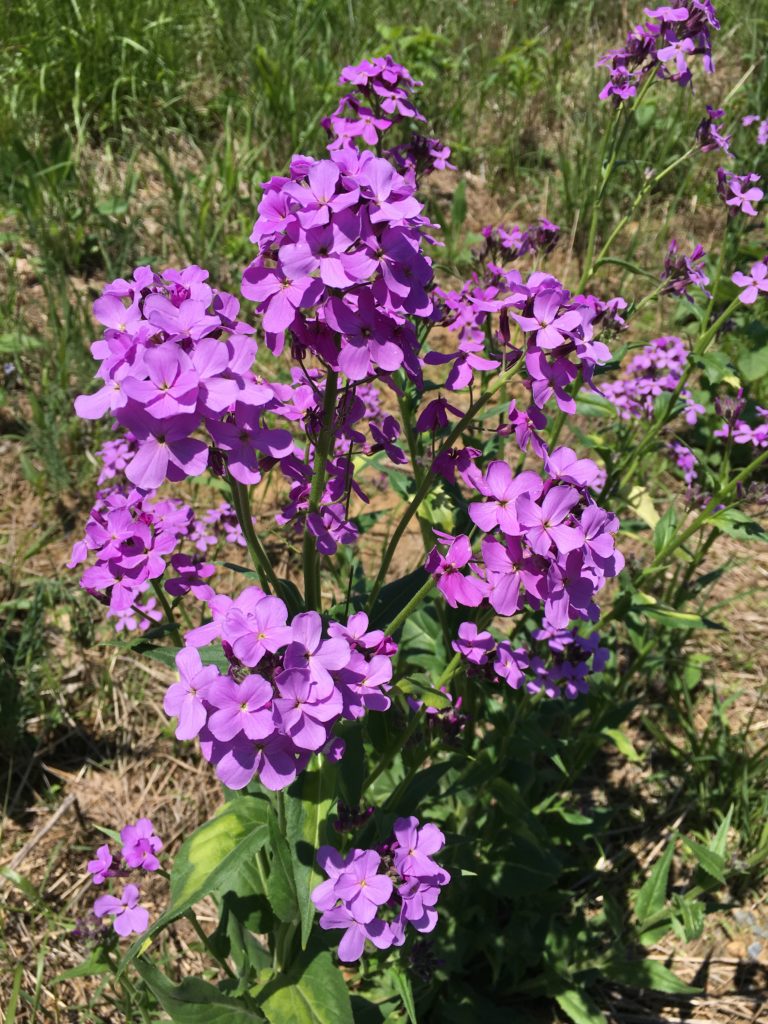
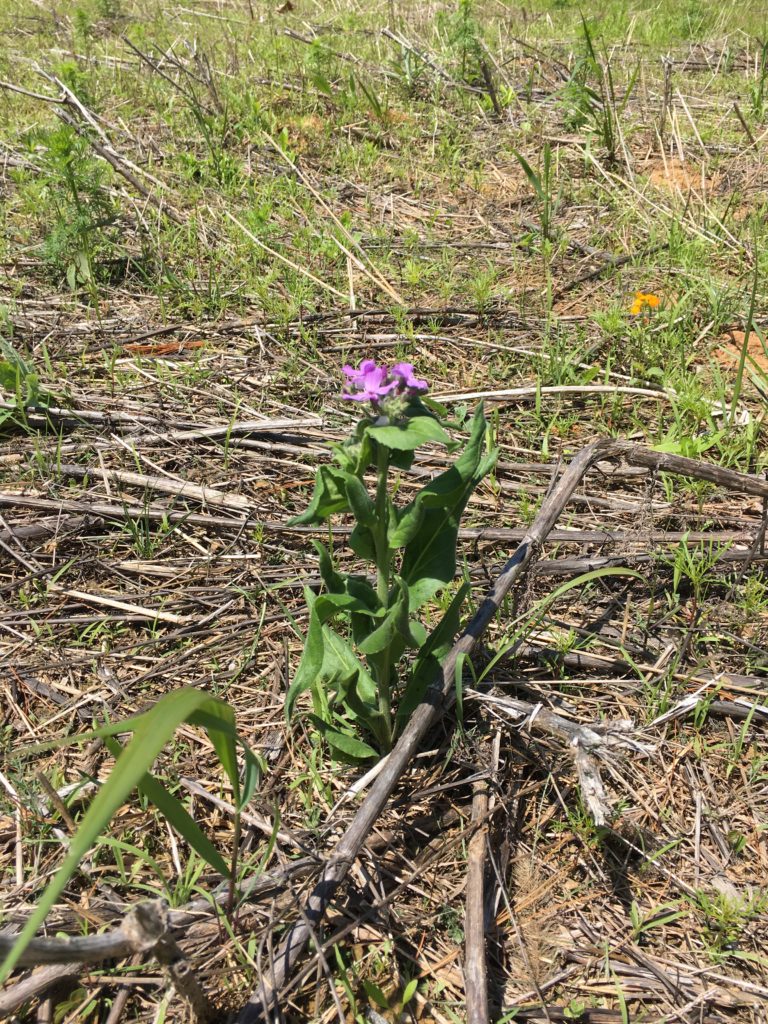 The Year 2 early blooms indicated that the Old Construction Road was still suffering from compaction. In Year 1 we used a tractor based slicing attachment to lift and open the compacted soil with good results. But in comparing the growth of two Phlox plants – the left one attempting to grow in the Old Construction Road and the one on the right robustly growing in the main field, you can see that compaction remains an issue.
The Year 2 early blooms indicated that the Old Construction Road was still suffering from compaction. In Year 1 we used a tractor based slicing attachment to lift and open the compacted soil with good results. But in comparing the growth of two Phlox plants – the left one attempting to grow in the Old Construction Road and the one on the right robustly growing in the main field, you can see that compaction remains an issue.
The hope is that, over time, encouraging the growth of grasses and herbaceous plants and leaving the end of seasons mowing detritus to decompose in place, will help to naturally open up the soil. The meadow soil is managed as no-till so that the intricate and delicate soil web is allowed to develop and heal itself; resisting compaction and optimally managing moisture. This soil health is aided by mycorrhizal fungi and bacteria that support and hold the soil particles. These fungi flourish in no-till soil and after a few years, should produce an open and friable soil. For more information about no-till and mycorrhizal fungi, see the PA Natural Resources and Conservation Service’s website.
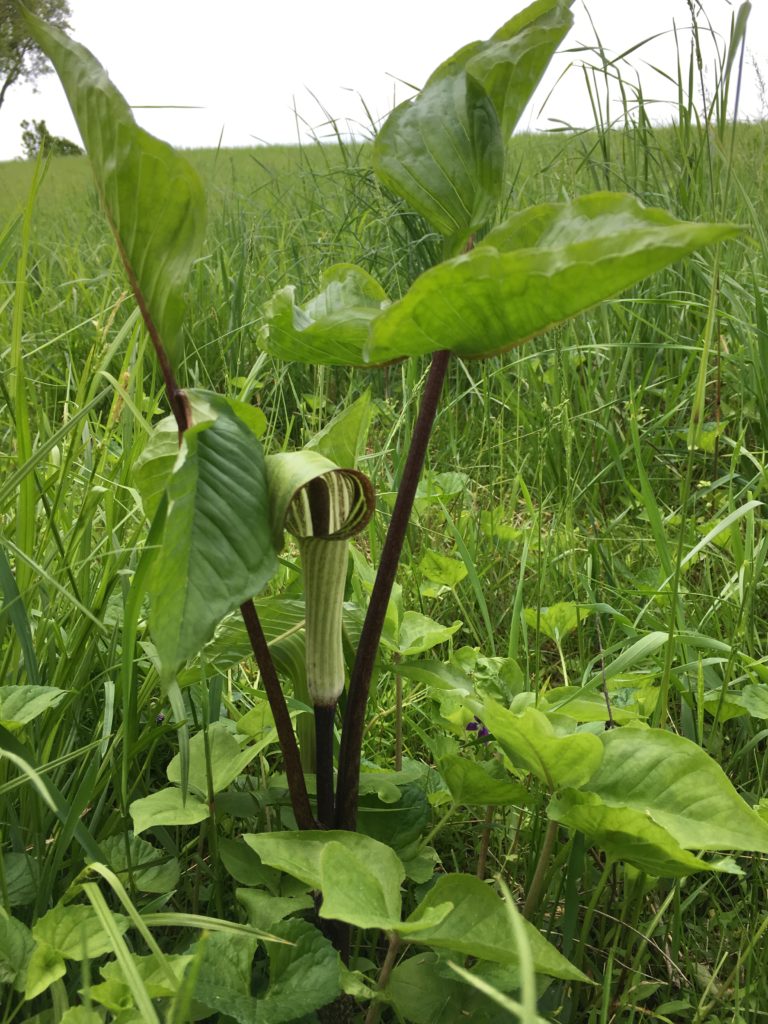 In Year 1 the field was allowed to grow to see what was naturally in the soil. We were rewarded with a huge diversity of
In Year 1 the field was allowed to grow to see what was naturally in the soil. We were rewarded with a huge diversity of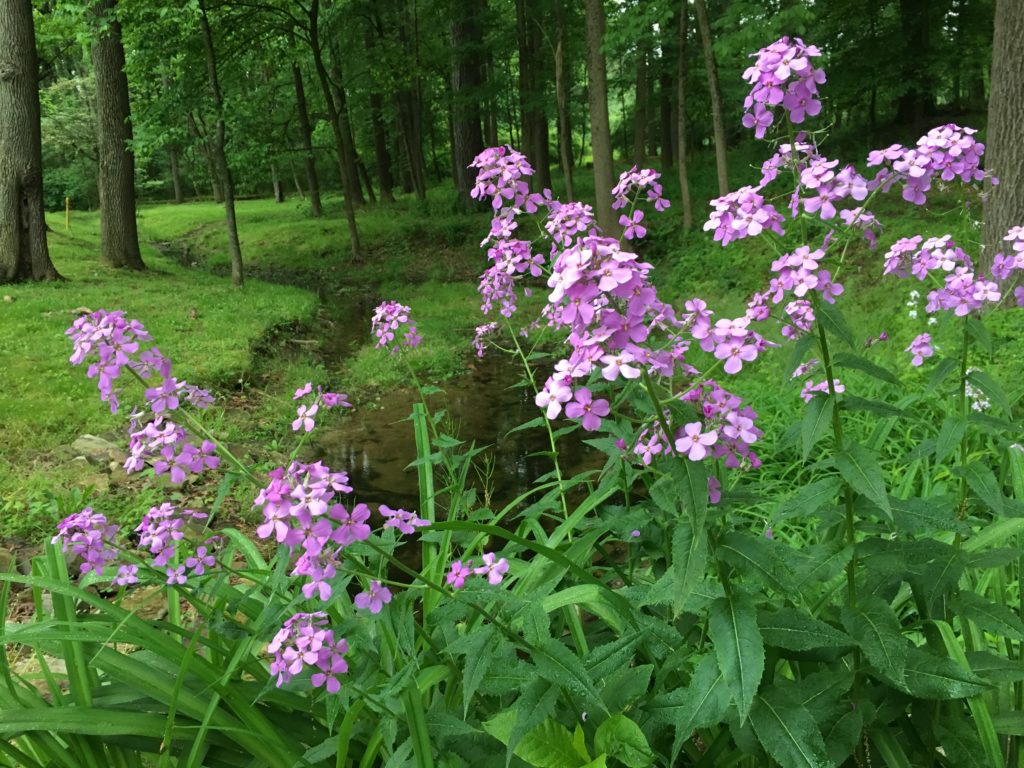 bgrasses, lots of Milkweed, some Goldenrod and New England Aster mixed with a few other species but, except for Japanese Stilt Grass, not much grew at the streamside. What a wonderful surprise to come across a large group of Jack-in-the-Pulpit (Arisaema triphyllum) thriving below the flood line.
bgrasses, lots of Milkweed, some Goldenrod and New England Aster mixed with a few other species but, except for Japanese Stilt Grass, not much grew at the streamside. What a wonderful surprise to come across a large group of Jack-in-the-Pulpit (Arisaema triphyllum) thriving below the flood line.
I am always intrigued by Jack-in-the-Pulpit flowers; some of which are male and others female, that trap fungus gnats for pollination – the male flower provides the gnat with an escape hatch while the female flower traps and keeps the gnat…forever. Once pollinated by the gnat, the female produces big, beautiful, edible, red berries in late summer and fall.
Native Phlox also appeared below the flood line – beautiful, colorful and a pollinator magnet.
June: Gardening
The compaction in the Old Construction Road that hampered the Phlox was also evident in the rate of grass growth. When the old field was 3’ high, the old road was a mere 4-6”. All was not lost though – there was hope in the flowers.
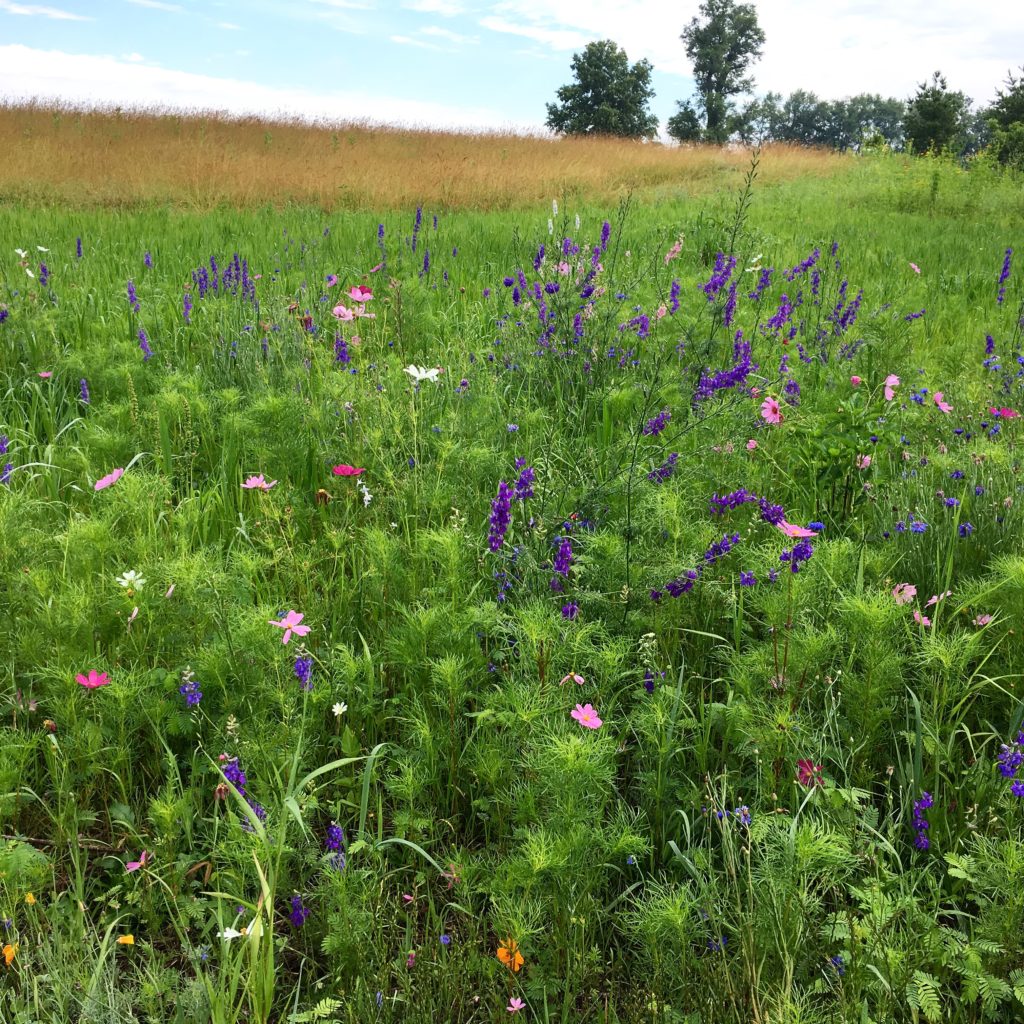 The Year 1 seed mixes contained a significant amount of native, perennial wildflowers and an awful lot of annual Cosmos. Many of the perennials are species that need some time to get established. Hidden among the season-long Cosmos show, they set roots and prepared for their appearance in the second year.
The Year 1 seed mixes contained a significant amount of native, perennial wildflowers and an awful lot of annual Cosmos. Many of the perennials are species that need some time to get established. Hidden among the season-long Cosmos show, they set roots and prepared for their appearance in the second year.
Among those, scattered about in the old road, Delphinium developed to grow tall and proud. Delphinium are excellent plants for assisting with decompaction. A perennial with a deep anchor root that it uses to store water and nutrients for the next year’s growth, Delphinium breaks through the soil to send out many feeder roots that form eyes for new flowers. Early in the Year 2 display the annual seeds of Cosmos and Blue Cornflower as well as the perennials, Clover and Poppy, that had been seeded across the old road, only bloomed in companionship with the Delphinium; nowhere else. This may be coincidence but it seems there may be some symbiosis or maybe they enjoyed each other’s company and may have been relying on the help of the established Delphinium to find a way to thrive.
As summer heated up I had more and more company in the meadow: butterflies, bees and other pollinators, and, frustratingly, invasive plants. I think that most plants (except of course poison ivy), have a place in the garden – if you plan for them. The meadow plan calls for a healthy diversity that does not include Multiflora Rose, Tree of Heaven, Cherry, Poplar, Thistles, Wild Raspberry and Stinging Nettle. These unplanned for invasives, are cagy plants. They grow hidden under the height of their neighbors, gaining strength and then, when huge, seemingly spring up as giant thugs OR they go from new flower to seed in the blink of an eye so that they can spread themselves around to maximum effect.
June was a month filled with walking the fields with three things: my trusty sharpened Felco pruners, thick gloves, long, thornproof sleeves and a small spray bottle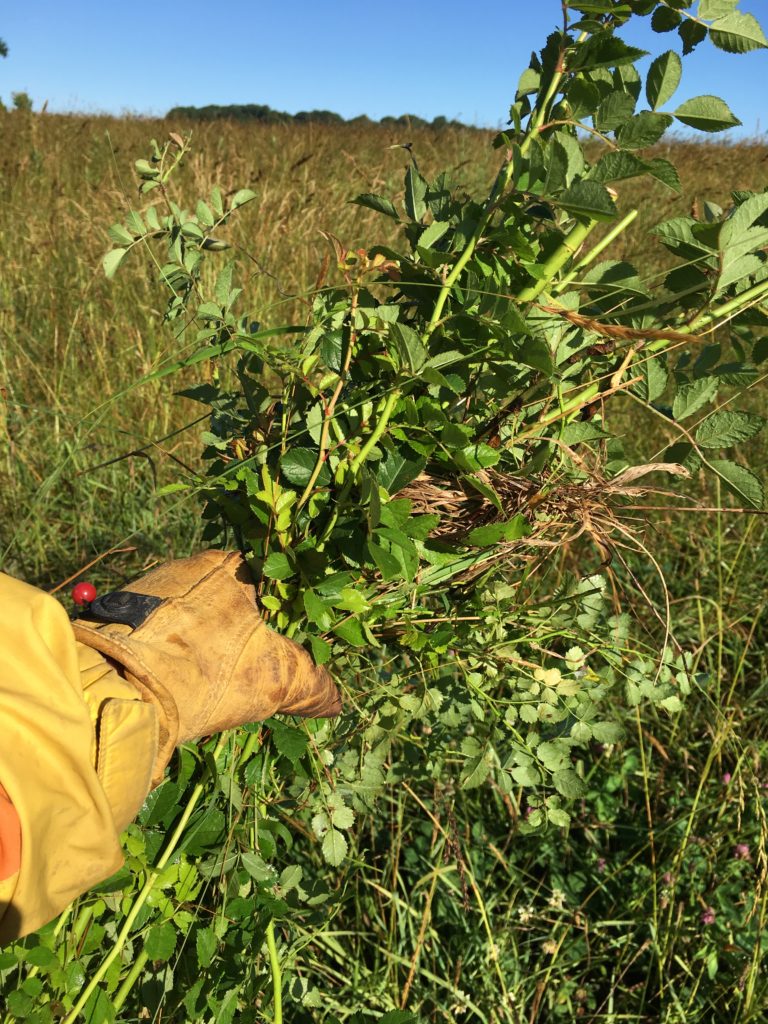 of white vinegar. The process is labor intensive: find the unwanted, thuggish plant, cut it to the base, slice the base open and pinpoint spray it with vinegar to – cross your fingers – kill it. Without fail I miss a few but this may be good on the pollinator side as I see that ladybugs, lightning bugs, and bees love thistle flowers. Although the ladybugs and bees have many other choices, I have never noticed a lightning bug on any other flower.
of white vinegar. The process is labor intensive: find the unwanted, thuggish plant, cut it to the base, slice the base open and pinpoint spray it with vinegar to – cross your fingers – kill it. Without fail I miss a few but this may be good on the pollinator side as I see that ladybugs, lightning bugs, and bees love thistle flowers. Although the ladybugs and bees have many other choices, I have never noticed a lightning bug on any other flower.
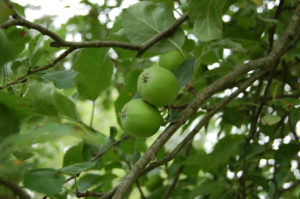 One indicator of the health of the pollinator population is the apple tree crop along the edge of the meadow. These old trees have THE BEST apples I have ever tasted and are wonderful to eat right off the tree or made into chutney and applesauce. The annual Mill Road Applesauce is a coveted product that I put-up to enjoy all winter. The Year 2 crop was prolific and beautiful. A good sign that there are happy bees – native and honey bees – living nearby.
One indicator of the health of the pollinator population is the apple tree crop along the edge of the meadow. These old trees have THE BEST apples I have ever tasted and are wonderful to eat right off the tree or made into chutney and applesauce. The annual Mill Road Applesauce is a coveted product that I put-up to enjoy all winter. The Year 2 crop was prolific and beautiful. A good sign that there are happy bees – native and honey bees – living nearby.
The Year 2 meadow is alive with color, sound and movement – the hot days of summer are to come.
